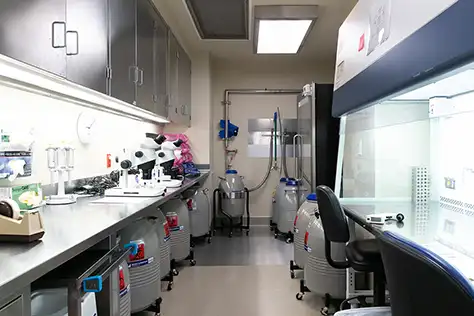Embryo Freezing and Storage
How embryos are preserved after an IVF cycle.
Embryo Cryopreservation and Storage After IVF
Sometimes more embryos are produced in an IVF cycle than can be safely transferred to the uterus because of concerns about multiple births. When this is the case, it may be possible to freeze the extra embryos for use in a future IVF cycle. This process is known as cryopreservation. Only embryos that are considered to be viable and of good quality are frozen or cryopreserved.

Cryopreservation involves gradually freezing embryos in a variety of special media. Embryos can be frozen because of the relatively strong outer cell membrane, the zona pellucida (glycoprotein coating), which surrounds an embryo and helps protect it during the cryopreservation process.
Although eggs have a zona pellucida similar to that of an embryo, they have a much higher water content. This makes them more fragile when frozen because the water tends to form ice crystals, causing cell (egg) damage. Human eggs have been successfully cryopreserved, but this is still considered an experimental procedure reserved for women who will undergo therapies (cancer chemotherapy or radiation) that will likely destroy their ovaries and eggs.
Embryos must be carefully thawed in a variety of sequential media to prevent cell rupture. The maximum length of time an embryo can remain viable when frozen is not known. Successful pregnancies have resulted from embryos that were more than twelve years old.
Approximately one in four couples undergoing IVF will have an excess number of embryos that may be cryopreserved (on culture Day 5-6). While embryos can be frozen at various stages during an IVF cycle (day 1, day 3, etc.), our usual strategy is to freeze at the blastocyst stage (Day 5-6). Pregnancy rates using frozen and thawed embryos are usually lower than when fresh embryos are used.
The major advantages to using cryopreserved embryos are simplified treatment and reduced costs. The patient only needs to undergo uterine preparation by way of hormone replacement, and then an embryo transfer, to complete a FET. Since the embryos are already available, it is not necessary to undergo a stimulation cycle with fertility drugs, thus lowering the cost.